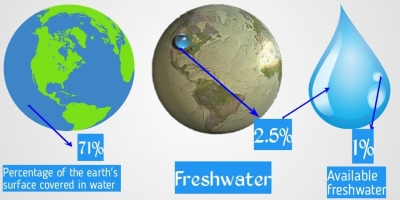
Water is a finite resource: there are some 1 400 million cubic kilometres on earth and circulating through the hydrological cycle. Nearly all of this is salt water and most of the rest is frozen or underground. Only one-hundredth of 1 percent of the world’s water is readily available for human use.
According to the U.S. Geological Survey, most of that three percent is inaccessible. Over 68 percent of the fresh water on Earth is found in icecaps and glaciers, and just over 30 percent is found in ground water. Only about 0.3 percent of our fresh water is found in the surface water of lakes, rivers, and swamps. Of all the water on Earth, more than 99 percent of Earth’s water is unusable by humans and many other living things! It seems extraordinary that the water that supports all terrestrial, as well as aquatic, life on our planet is actually so scarce. With this stunning realization comes a recognition that we have to utilize this resource very wisely. An important first step is to educate ourselves and future generations of citizens.
We can make better consumer, voter, and community member choices when we are informed about how we use resources, the ramifications of misuse, and solutions and actions to prevent fresh water issues. This guide was developed to support teachers in teaching topics with real-world context, and provide them with the background to feel competent and comfortable when teaching about fresh water. It provides a solid introduction to fresh water in an accessible and reader-friendly manner. In addition to general information about fresh water, the guide includes numerous education features, such as teaching tips and student thinking, that help to connect the content to classroom practice.
Credit : National Geographic Society
Picture Credit : Google

